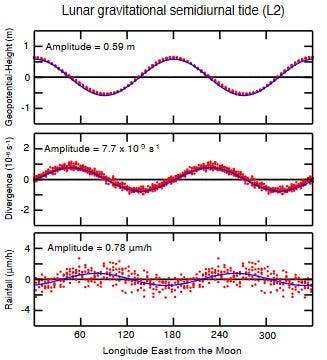The moon does more than cause tides and delight lovers – according to a new study, it can also affect how much rainfall falls down on the ground.

Since ancient times, the moon has been an object of fascination for people, both romantics and scientists. Now, researchers from the University of Washington found that when the moon is high in the sky, it creates “bulges” in the planet’s atmosphere, slightly affecting falling rain. This is the first study to document the effect of the moon on rainfall.
“As far as I know, this is the first study to convincingly connect the tidal force of the moon with rainfall,” said corresponding author Tsubasa Kohyama, a UW doctoral student in atmospheric sciences.

He started noticing something was up while studying atmospheric waves, periodic disturbances of pressure, temperature or wind velocity. He noticed slight, but consistent oscillations in the air pressure. He and co-author John (Michael) Wallace, a UW professor of atmospheric sciences, spent the next two years tracking these oscillations and attempting to explain them.
It’s not the first time atmospheric variations have been tied with the moon. Air pressure changes were connected to the phases of the moon back in 1847 and temperature in 1932. Furthermore, a 2014 paper from the same University showed how air pressure varies with the phases of the moon.
“When the moon is overhead or underfoot, the air pressure is higher,” Kohyama said.
After that, it seemed highly likely that rainfall is also affected by the moon, and this did turn out to be the case. When the satellite is overhead, its gravitational attraction tugs and pulls a slight damper on the rain. Higher pressure also creates warmer temperatures in the air parcels below. Warmer air holds more moisture, and having a higher moisture capacity means they don’t shed as much water.
“It’s like the container becomes larger at higher pressure,” Kohyama said. The relative humidity affects rain, he said, because “lower humidity is less favorable for precipitation.”
They used data collected from 1998 to 2012 to show that the rain is indeed slightly lighter when the moon is high. It’s a very slight and subtle change, of only about 1% total rainfall. It is consistent, but you shouldn’t really worry about it.
“No one should carry an umbrella just because the moon is rising,” Kohyama said.
However, this could have an effect on weather and climate models. It’s another valuable piece of information to piece into extremely complicated prediction models. Wallace plans to continue exploring the topic to see whether specific types of rain are more affected by lunar phases.
Journal Reference [open access] – Rainfall variations induced by the lunar gravitational atmospheric tide and their implications for the relationship between tropical rainfall and humidity.



